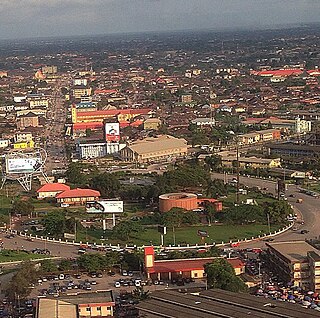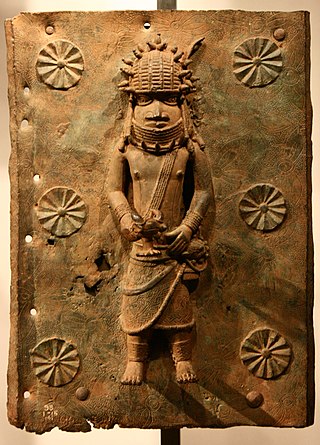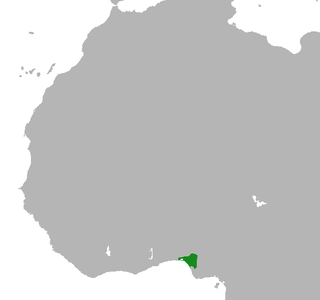Related Research Articles

Benin City is the capital and largest city of Edo State, southern Nigeria. In central Kings square, the Benin city National Museum traces the Benin empire and has displays of terracotta sculpture. The Oba's palace is known for bronze plaques that once decorated with the walls, depicting historical events and Life at court. It is the fourth-largest city in Nigeria according to the 2006 census, after Lagos, Kano, and Ibadan. It is situated approximately 40 kilometres (25 mi) north of the Benin River and 320 kilometres (200 mi) by road east of Lagos. Benin City is the centre of Nigeria's rubber industry, and oil production is also a significant industry.
The Benin Expedition of 1897 was a punitive expedition by a British force of 1,200 men under Sir Harry Rawson purportedly in response to the ambush of a previous British embassy under Acting Consul General James Phillips, of the Niger Coast Protectorate. Rawson's troops captured and sacked Benin City, bringing to an end the Kingdom of Benin, which was eventually absorbed into colonial Nigeria.

The Oba of Benin is the traditional ruler and the custodian of the culture of the Edo people and all Edoid people. The then Kingdom of Benin has continued to be mostly populated by the Edo.

The Benin Bronzes are a group of several thousand metal plaques and sculptures that decorated the royal palace of the Kingdom of Benin, in what is now Edo State, Nigeria. Collectively, the objects form the best examples of Benin art and were created from the thirteenth century by artists of the Edo people. The plaques, which in the Edo language are called Ama, depict scenes or represent themes in the history of the kingdom. Apart from the plaques, other sculptures in brass or bronze include portrait heads, jewelry, and smaller pieces.

The Esan people (Esan: are an ethnic group of southern Nigeria who speak the Esan language. The Esan are traditionally known to be agriculturalists, trado-medical practitioners, mercenary warriors and hunters. They cultivate palm trees, Irvingia gabonensis, Cherry, bell pepper coconut, betel nut, kola nut, black pear, avocado pear, yams, cocoyam, cassava, maize, rice, beans, groundnut, bananas, oranges, plantains, sugar cane, tomato, potato, okra, pineapple, paw paw, and various vegetables.

Oba Esigie was the son of Oba Ozolua, who reigned in the late 15th century, and his second wife, Queen Idia. Oba Esigie ruled the ancient Benin Kingdom, now Benin City, Edo State, Nigeria. Works of art commissioned by Esigie are held in prominent museums including the Metropolitan Museum of Art and the British Museum.

The Oba of Lagos, also known as the Eleko of Eko, is the traditional ruler (Oba) of Lagos.

Benin art is the art from the Kingdom of Benin or Edo Empire (1440–1897), a pre-colonial African state located in what is now known as the Southern region of Nigeria. Primarily made of cast bronze and carved ivory, Benin art was produced mainly for the court of the Oba of Benin – a divine ruler for whom the craftsmen produced a range of ceremonially significant objects. The full complexity of these works can be appreciated through the awareness and consideration of two complementary cultural perceptions of the art of Benin: the Western appreciation of them primarily as works of art, and their understanding in Benin as historical documents and as mnemonic devices to reconstruct history, or as ritual objects. This original significance is of great importance in Benin.

Ikegobo, the Edo term for "altars to the Hand," are a type of cylindrical sculpture from the Benin Empire. Used as a cultural marker of an individual's accomplishments, Ikegobo are dedicated to the hand, from which the people of Benin considered the will for wealth and success to originate. These commemorative objects are made of wood or brass with figures carved in relief around their sides.
Igueben is a local government area of Edo State, Nigeria. Its headquarters are located in the town of Igueben, which has an area of 380 km2 (150 sq mi) and a population of 69,639 according to the 2006 census. The postal code is 310.

The Kingdom of Benin, also known as the Edo Kingdom or the Benin Empire, was a kingdom within what is now southern Nigeria. It has no historical relation to the modern republic of Benin, which was known as Dahomey from the 17th century until 1975. The Kingdom of Benin's capital was Edo, now known as Benin City in Edo State, Nigeria. The Benin Kingdom was "one of the oldest and most developed states in the coastal hinterland of West Africa". It grew out of the previous Edo Kingdom of Igodomigodo around the 11th century AD, and lasted until it was annexed by the British Empire in 1897.

The Akure Kingdom is a traditional state with headquarters in Akure, Ondo State, Nigeria. It is the successor to an ancient Yoruba city state of the same name. The ruler bears the title "Deji of Akure".
Ashipa, the founder of the Lagos royal dynasty but uncrowned as Oba of Lagos, whom all Obas of Lagos trace their lineage to, was an Awori Chieftain from Isheri. Ashipa was rewarded with title of Oloriogun after returning the body of one Asheru, a Benin war captain to Benin and received the Oba of Benin's sanction to govern Lagos. Some Benin accounts of history have the Ashipa as son or grandson of the Oba of Benin. According to the Lagos traditional account however, Ashípa was a local native, an Awori Yoruba chieftain of Isheri.
Nigerian heraldry is the system of heraldry that exists in Nigeria. It dates to the country's pre-colonial period, and due to an absence of a central heraldic authority, it is currently largely unregulated.
The Uzama also known as King Makers in the Benin Kingdom, are among the highest ranking chiefs in Benin History. Just like the Oyomesi of the old Oyo empire, the Uzama are saddled with the responsibility of crowning a new king in the Benin Kingdom. From ancient Benin History, the Uzama reign started during the Ogiso era and they consist of four chiefs which is headed by Chief Oliha. Other chiefs holding the Uzama title include Edohen, Ero and Eholo Nire. While the Chiefs were responsible for crowning the King or the Oba of Benin, they do not have the power to choose the king.
The ancient gates of Benin Kingdom were the nine access point into the Kingdom of Benin, in what is today known as Benin City. The city is known to be surrounded by wide inner walls made of earthwork and moats. In the 1974 edition of the Guinness Book of Records, it described the Benin City walls as the largest earthwork carried out before the Mechanical period. Part of the walls were believed to be about 65 ft (20 m) tall. The ancient walls in the Benin Kigdom were transformed to the access point or gates to the city. These gates include Iya Uzebu, Iya Osuan, Iya Urh'Ogba, Iya Ivbiyeneva, Iya Uhunmwun Idunmwun, Iya Akpakpava or Iya Ok'Edo, Iya Ewaise, Iya Ero, and Iya Isekhere.
Ezomo may refer to:
Ogbebo ruled within the Benin Empire in 1816 AD, albeit for a brief period. His time in power was marked by a contest for control of the Benin throne, leading to a civil conflict.

Osemwende, originally known as Prince Eredia-uwa, was the Oba of Benin from 1816 to 1848. He was the son of Oba Obanosa and the brother of Ogbebo, whom he defeated in a civil war to claim the throne. He restored peace and stability to the kingdom after a turbulent period of succession crisis and expanded and consolidated his empire through military conquests and diplomatic alliances. He also promoted trade and commerce with foreign nations, especially the Portuguese, and fostered art and learning among his people. He was revered as a wise and benevolent ruler who brought good tidings to his kingdom.

The Akure–Benin War, which took place in 1818 AD, was a conflict between the Benin Kingdom and the Akure Kingdom in what is now Nigeria. The origins of this conflict can be traced back to the complex history of the region, with Akure being a place of ancient settlements, some dating back to the early Ife kingdom. The Akure Kingdom emerged when these communities were consolidated under the rule of Prince Omoremilekun, who descended from Oduduwa, a revered figure in Yoruba history. Historically, the relationship between Benin and Akure had been marked by peace and mutual respect due to shared cultural heritage and ancestry.
References
- ↑ "The Ezomo Of Uzebu". edoworld.net. Retrieved 2023-01-22.
- ↑ Girshick, Paula Ben-Amos; Thornton, John (2001). "Civil War in the Kingdom of Benin, 1689-1721: Continuity or Political Change?". The Journal of African History. 42 (3): 353–376. doi:10.1017/S0021853701007915. hdl:2022/3613. ISSN 0021-8537. JSTOR 3647167. S2CID 145691565.
- ↑ www.metmuseum.org https://www.metmuseum.org/art/collection/search/317781 . Retrieved 2023-01-22.
{{cite web}}: Missing or empty|title=(help) - ↑ "Fracas between two factions at Uzebu Community resolved by elders". Independent Television/Radio. 2013-07-30. Retrieved 2023-01-22.